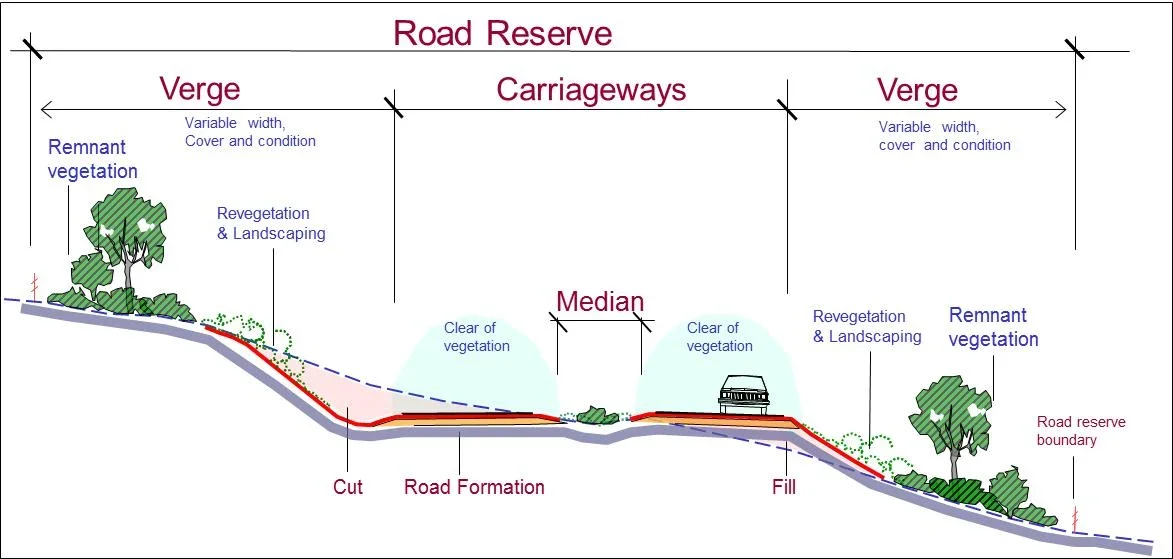🌿 Revegetation and Landscaping: Building Sustainable Road Corridors
Integrating Ecology into Modern Road Infrastructure
Revegetation and landscaping are essential components of sustainable road design. They stabilise soil, control erosion, and restore natural balance after construction. More than an aesthetic element, they are a functional part of road engineering that supports drainage, biodiversity, and long-term asset performance.
As transport networks expand, the focus has shifted toward creating corridors that are not only safe and efficient but also environmentally responsible. The landscape surrounding a road is now recognised as part of the asset system, influencing its resilience, maintenance needs, and community value.
Understanding the Road Reserve
The diagram below illustrates a typical road reserve layout, showing how revegetation and landscaping work together across different zones to stabilise slopes, support vegetation, and maintain clear sightlines for safety.
Credit: Mainroads.wa.gov.au.
Purpose and Design
Revegetation and landscaping refer to treatments that re-establish vegetation suited to local conditions, thereby improving the ecological and visual value of road reserves. In rural areas, they protect slopes, manage runoff, and preserve native ecosystems. In urban settings, they soften hard surfaces such as kerbs, medians, and drainage channels while improving stormwater infiltration.
Together, these elements connect engineering performance with environmental design. They ensure that infrastructure blends naturally into its surroundings while protecting structural integrity and safety.
Key Design Objectives
Effective road corridor landscaping must achieve both technical and ecological outcomes:
Safety: Maintain clear sightlines and provide recovery areas free of fixed obstacles.
Functionality: Reduce impermeable surfaces and manage stormwater effectively.
Biodiversity: Use native vegetation suited to local climates and soil conditions.
Maintainability: Ensure treatments are durable, low-maintenance, and safe for crews.
Visual Appeal: Create cohesive, uncluttered corridors that reflect local landscape character and improve driver comfort.
At high-visibility locations such as interchanges or civic gateways, Priority Maintenance Zones may apply higher standards, including irrigated plantings and decorative finishes, to enhance visual impact without compromising safety.
Technical and Environmental Integration
Industry specifications outline clear requirements for earthworks, soil preparation, and planting. Typical road reserves are divided into functional zones such as the roadway, maintenance zone, and vegetation zone, each serving a defined role in drainage, safety, and environmental performance.
Soil stability is critical. Surfaces should be shaped to direct runoff away from the kerb while promoting infiltration. Recommended soil depths range from 70 millimetres for grassed areas to 135 millimetres for planting. Coarse organic mulch, graded between 15 and 80 millimetres, provides durability, fire resistance, and erosion control.
Vegetation design must balance safety with ecology. Trees are placed outside recovery areas or behind barriers, while low native species are used in medians and verges to maintain visibility. Compact native plants such as Grevillea thelemanniana and Grevillea obtusifolia are favoured for their resilience and low water demand.
Critical Challenges
Safety and Ecology Conflict: The need for clear recovery zones limits the type and density of vegetation that can be used. Low vegetation profiles and frequent mowing reduce habitat diversity and may create runoff or emissions from maintenance activities.
Ecological Restoration Limits: Shallow soil profiles and minimal planting diversity make it difficult to achieve long-term ecosystem resilience. True restoration requires local seed provenance, diverse species, and ongoing monitoring.
Budget Constraints: Pressure to deliver low-maintenance landscapes can result in the selection of inexpensive, non-native grasses over native vegetation. Long-term funding consistency is also vital for maintaining Priority Maintenance Zones.
PMS Perspective
At Pavement Management Services, we recognise that the surrounding environment is a vital part of every road asset. Our asset management system integrates vegetation data, soil condition, and maintenance cycles to support sustainable road networks.
By combining environmental monitoring with pavement performance modelling, PMS helps asset owners plan smarter interventions that enhance safety, drainage, and ecological outcomes. This data-driven approach ensures that landscaping and revegetation contribute directly to the long-term management of road assets.
Conclusion
Revegetation and landscaping are key to building road corridors that are safe, resilient, and environmentally sustainable. When designed with both safety and ecology in mind, they improve drainage, preserve biodiversity, and reduce whole-of-life costs.
At Pavement Management Services, we continue to support governments and asset managers in creating sustainable road infrastructure that balances engineering precision, community expectations, and environmental responsibility.

